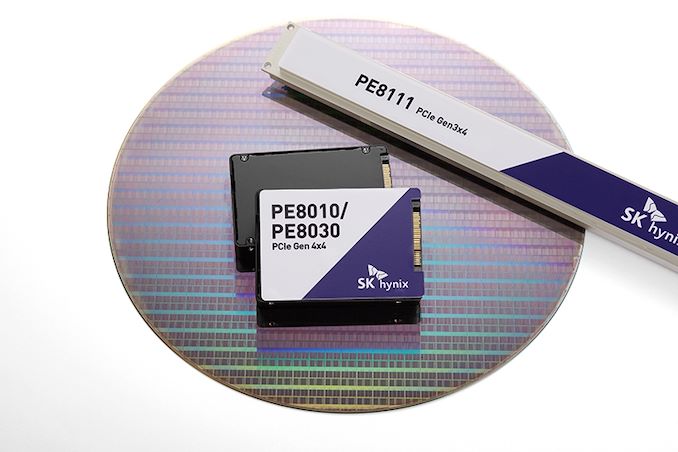SK Hynix Sampling New PCIe 4.0 96L SSDs, 128L 4D NAND Enterprise SSDs
by Andrei Frumusanu on April 8, 2020 11:00 AM EST
SK Hynix today announced that they’ve begun sampling of its first ever PCIe 4.0 enterprise SSDs in the form of the new 96-layer 3D-NAND U.2/U.3 form-factor PE8010 and PE8030 eSSDs, as well as announcing plans to sample the new PE81111 EDSFF E1.L SSDs based on their 128-layer “4D NAND” flash modules later in the year.
We had expected the new PE8111 eSSD for some time know as we reported about SK Hynix’s plans to introduce such a product last November. The biggest change here is the company’s use of new 128-layer 3D NAND modules that the company dubs as “4D-NAND” because of a new denser cell structure design and higher per-die I/O speeds.

16TB Enterprise EDSFF E1.L SSD
The PE8111 still retains as PCIe 3.0 interface and its corresponding performance characteristics plateau at 3400MB/s sequential reads and 3000MB/s sequential writes – whilst supporting random reads and writes up to respectively 700K and 100K IOPs. Because it’s a long-factor EDSFF E1.L form-factor, storage capacity for the unit falls in at 16TB, and SK Hynix is reporting that they’re working on a 32TB solution in the future.
The new PE8010 and PE8030 come in an U.2/U.3 form-factor and are the company’s first SSDs support PCIe 4.0. The SSDs here still rely on 96-layer NAND modules from the company – but are using an in-house controller chip. Bandwidth here is naturally higher, reaching up to 6500MB/s reads and 3700MB/s write sequentially, with random IOPs falling in at respectively 1100K for reads and 320K for writes.
Power consumption for the new U.2/U.3 drives is actually extremely competitive given their jump to PCIe 4.0 – rising only up to 17W as opposed to their previous generation PCIe 3.0 products which fell in at 14W. This is likely to be attributed to the new generation custom controller, which might be more optimised for low-power compared some or the early third-party 4.0 controllers out there.
The PE8010 and PE8030 are sampling right now with customers – with the PE8111 planned to be sampled in the second half of the year.
Related Reading:
- Enterprise NVMe Round-Up 2: SK Hynix, Samsung, DapuStor and DERA
- SK Hynix to Cut CapEx, Accelerate Transitions, 1z nm DRAM & 128L 4D NAND in 2020
- SK Hynix Sampling 128-layer 3D NAND SSDs
- SK Hynix NAND Update: 3D NAND Output Cut, Slowdown Capacity Expansions
- SK Hynix Starts Production of 128-Layer 4D NAND, 176-Layer Being Developed
Source: SK Hynix










40 Comments
View All Comments
06GTOSC - Wednesday, April 8, 2020 - link
What is the expected max writes from a drive like this?Billy Tallis - Wednesday, April 8, 2020 - link
Based on their usual product naming scheme, these should be 1 DWPD and 3 DWPD.Hulk - Wednesday, April 8, 2020 - link
Normal questions. How fast? How big? How much?schujj07 - Wednesday, April 8, 2020 - link
How fast - plenty especially when using in a vsan array. I manage a Software Defined Storage array with Micron 9300 Pros on a dual port 25GbE iSCSI connection. I can start up a 300GB RAM HANA DB in 2 minutes.How big - will depend on the DWPD rating. Micron 9300 Pro series are 3.84, 7.68, & 15.36TB all at 1DWPD. Micro 9300 MAX series are 3.2, 6.4, & 12.8TB all at 3DWPD. I would assume these will have similar capacities.
How much - if you have to ask you cannot afford it.
azfacea - Wednesday, April 8, 2020 - link
cool, if SSD performance keeps improving like this, it can provide competitive pressure to DRAM which is still controlled by a price fixing triad.schujj07 - Wednesday, April 8, 2020 - link
Even the fastest SSD are several orders of magnitude slower than DRAM.azfacea - Wednesday, April 8, 2020 - link
very smart analysis, i dont know why they dont give you a nobel prize. its like saying TSMC 5nm transistors are better than older ones. therefore there is no point in anything else existing.close - Thursday, April 9, 2020 - link
Stop being a douche (if you can, that is). I know you get a tingly sensation in your peepee every time you think of SSDs but they are not the answer to everything. If you need DRAM levels of performance then NAND *will not* do it. And it's not like NAND manufacturers will be eager to give you stuff for free because they're DEFINITELY not the same companies manufacturing DRAM (Samsung? Micron? For example...).You made a stupid comparison and you think getting sarcastic will get you out of it? Sure, and if they improve energy efficiency at this rate pretty soon they'll generate electricity.
The example of consoles is probably the worst because they were stuck with *slow* SATA HDDs for the past ~15 (!) years. Storage was the only thing that was not upgraded for all that time - small, low performance 5400RPM SATA2 HDDs. Of course it would become a severe bottleneck at some point. They benefit a lot because boosting performance by 2-5GB/s means boosting it by 2000-5000%. This makes a difference for real life performance but still doesn't put it anywhere near DRAM levels of performance.
Hul8 - Saturday, April 11, 2020 - link
I don't think there's a Nobel price for correcting hot takes on the internet.azfacea - Wednesday, April 8, 2020 - link
have u heard of this thing called "network", is it possible that some1 might not care to use RAM or SSD that is faster than his network (in bw or latency) but does care not use storage that is slower than his network.